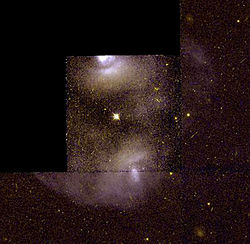- NGC 2371-2
-
NGC 2371 
A Hubble Space Telescope (HST) image of NGC 2371-2.
Credit: HST/NASA/ESA.Observation data
(Epoch J2000)Right ascension 7h 25m 34.7s[1] Declination +29° 29′ 25.6″[1] Distance 4400 ly Apparent magnitude (V) 13 Apparent dimensions (V) 44 Constellation Gemini Physical characteristics Other designations NGC 2371,[1] NGC 2372[1] See also: Planetary nebula, Lists of nebulae NGC 2371-2 is a dual lobed planetary nebula located in the constellation Gemini. Visually, it appears like it could be two separate objects; therefore, two entries were given to the planetary nebula by William Herschel in the "New General Catalogue", so it may be referred to as NGC 2371, NGC 2372, or variations on this name.[1]
Contents
Observations
At 13th magnitude, this nebula is well within the limits of most amateur telescopes. Like most planetary nebulae, this one responds well to both high magnification and narrow-band filters, especially an OIII emission filter. It is listed within the RASC's 110 Finest NGC List
How to find
NGC 2371-2 is in the Gemini constellation which is visible in the latitudes between +90° and −60°.This nebula is easy to find because it lies southwest of Castor. Start at Castor and use the two bright stars that form an equilateral triangle to the southwest as a guide to tell you which direction to sweep. The nebula lies between the widest pair of three 7th magnitude stars that lie in a straight line. This planetary nebula is located at a distance of 4400 light years.
External links
- The Hubble European Space Agency Information Centre Hubble picture and information on NGC 2371
- NGC 2371-2 on WikiSky: DSS2, SDSS, GALEX, IRAS, Hydrogen α, X-Ray, Astrophoto, Sky Map, Articles and images
References
- ^ a b c d e "SIMBAD Astronomical Database". Results for NGC 2371. http://simbad.u-strasbg.fr/Simbad. Retrieved 2007-04-20.
Categories:- Planetary nebulae
- Gemini constellation
- NGC objects
Wikimedia Foundation. 2010.

